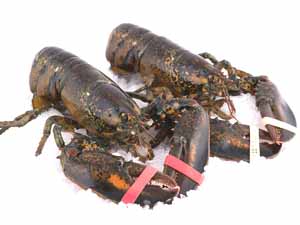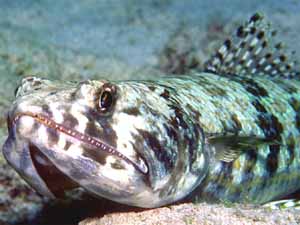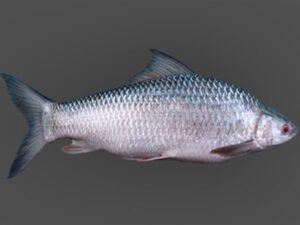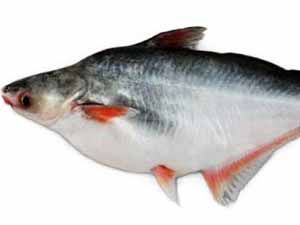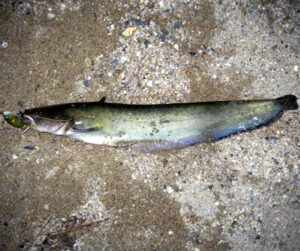The Atlantic menhaden fish is a species of fish from North America in the herring family, Clupeidae.
It is also known by some other names such as Bony fish, Bunker, Fatback, Menhadem, Menhaden, Bugfish, Mossbunker, Pogy, Whitefish and Moss Bunker.
It is mainly found in the North Atlantic coastal and estuarine waters from Nova Scotia south to northern Florida. It is also commonly found in all salinities of the Chesapeake Bay and Mid-Atlantic water.
Total population of the Atlantic menhaden fish declined in the past, but is now considered recovered (with strong evidence for continual increase in estimated biomass over the past three generation lengths).
And currently it is listed as Least Concern. However, read some more information about this fish species below.
Atlantic Menhaden Fish Characteristics
The Atlantic menhaden fish has a moderately compressed body and a black spot on the shoulder behind the gill openings.
It is mainly a silvery colored fish with some black spots. Back of these fish are dark bluish. They have small, irregularly placed scales on their backs, above the anal fins.
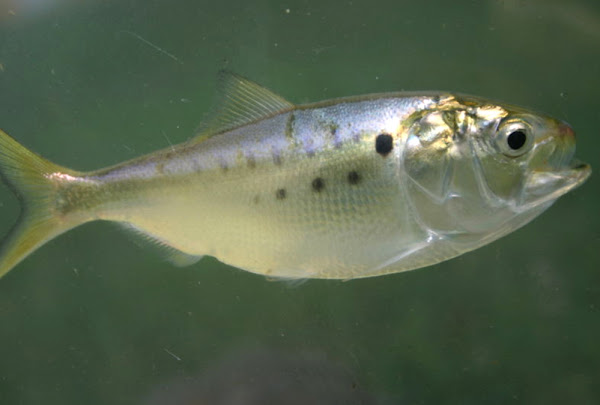
They have inner and outer finrays and a pelvic fin with rounded hind margins.
Average body length of the mature fish is around 15 inches. And the mature fish on average weight around 1.2 kg. Photo and info from Wikipedia.
Diet
The Atlantic menhaden fish are feed by filtering. They collect food by filtering water through modifications of the branchial apparatus (gill arches and gill rakers).
They generally consume from the primary trophic levels, including phytoplankton and zooplankton. Detritus (dead organic matter found in the water, generally settled on the bottom) is also their main food source.
Diet of these fish depends on the size of their gill rakers, which change as the fish age.
Breeding
The Atlantic menhaden fish can spawn year round in inshore waters off the Atlantic coast, with the highest spawning rates near North Carolina in the late fall.
The eggs hatch in the open ocean, and the larvae drift to sheltered estuaries via ocean currents. The young generally spend a year developing in these estuaries before returning to the open ocean. They are generally known as ‘peanut bunker‘ at this early age.
These fish become mature after their 2 years of age, and they reproduce until death. On an average, a mature female can produce roughly 38,000 eggs per spawning, but the fully mature female can lay up to 362,000 eggs.
Uses
The Atlantic menhaden fish is generally used for food. It is also used in the production of oil, fertilizer and fishmeal.
Special Notes
The Atlantic menhaden fish are considered highly commercial fish for the United States. They are generally found at a depth of up to 20 meters. They swim in large schools that stratify by size and age along the coast.
Younger and smaller fish are found in the Chesapeake Bay and southern coastline while older, larger fish are found along the northern coastline.
Average lifespan of these fish is up to 10-12 years. However, review full breed profile of the Atlantic menhaden fish in the table below.
| Name | Atlantic Menhaden |
| Kingdom | Animalia |
| Phylum | Chordata |
| Class | Actinopterygii |
| Order | Clupeiformes |
| Family | Clupeidae |
| Genus | Brevoortia |
| Species | B. tyrannus |
| Binomial Name | Brevoortia tyrannus |
| Other Names | Also known as Bony fish, Bunker, Fatback, Menhadem, Menhaden, Bugfish, Mossbunker, Pogy, Whitefish and Moss Bunker |
| Breed Purpose | Mainly food, also fertilizer, fishmeal and oil |
| Special Notes | Economically important fish species, generally found at a depth of up to 20m, can swim in large schools that stratify by size and age along the coast, 10-12 years average lifespan, used for food, fertilizer, fishmeal and oil |
| Weight | Around 1.2 kg |
| Breeding Method | Natural |
| Climate Tolerance | Native climates |
| Body Color | Silver |
| Rarity | Common |
| Availability | Worldwide |

